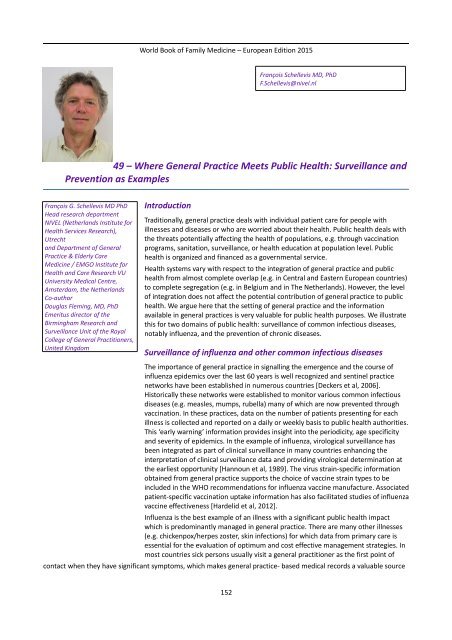Family Medicine
World Book 2015
World Book 2015
You also want an ePaper? Increase the reach of your titles
YUMPU automatically turns print PDFs into web optimized ePapers that Google loves.
World Book of <strong>Family</strong> <strong>Medicine</strong> – European Edition 2015<br />
François Schellevis MD, PhD<br />
F.Schellevis@nivel.nl<br />
49 – Where General Practice Meets Public Health: Surveillance and<br />
Prevention as Examples<br />
François G. Schellevis MD PhD<br />
Head research department<br />
NIVEL (Netherlands Institute for<br />
Health Services Research),<br />
Utrecht<br />
and Department of General<br />
Practice & Elderly Care<br />
<strong>Medicine</strong> / EMGO Institute for<br />
Health and Care Research VU<br />
University Medical Centre,<br />
Amsterdam, the Netherlands<br />
Co-author<br />
Douglas Fleming, MD, PhD<br />
Emeritus director of the<br />
Birmingham Research and<br />
Surveillance Unit of the Royal<br />
College of General Practitioners,<br />
United Kingdom<br />
Introduction<br />
Traditionally, general practice deals with individual patient care for people with<br />
illnesses and diseases or who are worried about their health. Public health deals with<br />
the threats potentially affecting the health of populations, e.g. through vaccination<br />
programs, sanitation, surveillance, or health education at population level. Public<br />
health is organized and financed as a governmental service.<br />
Health systems vary with respect to the integration of general practice and public<br />
health from almost complete overlap (e.g. in Central and Eastern European countries)<br />
to complete segregation (e.g. in Belgium and in The Netherlands). However, the level<br />
of integration does not affect the potential contribution of general practice to public<br />
health. We argue here that the setting of general practice and the information<br />
available in general practices is very valuable for public health purposes. We illustrate<br />
this for two domains of public health: surveillance of common infectious diseases,<br />
notably influenza, and the prevention of chronic diseases.<br />
Surveillance of influenza and other common infectious diseases<br />
The importance of general practice in signalling the emergence and the course of<br />
influenza epidemics over the last 60 years is well recognized and sentinel practice<br />
networks have been established in numerous countries [Deckers et al, 2006].<br />
Historically these networks were established to monitor various common infectious<br />
diseases (e.g. measles, mumps, rubella) many of which are now prevented through<br />
vaccination. In these practices, data on the number of patients presenting for each<br />
illness is collected and reported on a daily or weekly basis to public health authorities.<br />
This ‘early warning’ information provides insight into the periodicity, age specificity<br />
and severity of epidemics. In the example of influenza, virological surveillance has<br />
been integrated as part of clinical surveillance in many countries enhancing the<br />
interpretation of clinical surveillance data and providing virological determination at<br />
the earliest opportunity [Hannoun et al, 1989]. The virus strain-specific information<br />
obtained from general practice supports the choice of vaccine strain types to be<br />
included in the WHO recommendations for influenza vaccine manufacture. Associated<br />
patient-specific vaccination uptake information has also facilitated studies of influenza<br />
vaccine effectiveness [Hardelid et al, 2012].<br />
Influenza is the best example of an illness with a significant public health impact<br />
which is predominantly managed in general practice. There are many other illnesses<br />
(e.g. chickenpox/herpes zoster, skin infections) for which data from primary care is<br />
essential for the evaluation of optimum and cost effective management strategies. In<br />
most countries sick persons usually visit a general practitioner as the first point of<br />
contact when they have significant symptoms, which makes general practice- based medical records a valuable source<br />
152


